Nearly 1,800 men and women, dressed in black trousers and slacks, white shirts and black ties, lined up along the black-flag draped Andersonstown and Falls roads in west Belfast on Tuesday for the funeral of Bobby Storey.
Behind them stood thousands more as the hearse containing the Tricolour-covered coffin of Storey, a senior Sinn Féin and IRA figure for decades, passed by, applauding as it did. Even with the Covid-19 lockdown regulations in place, they were determined to pay tribute to a man they considered a hero.
However, there are others who experienced the brutal side of the 64-year-old, who hold sharply different views about the man lauded in Andersonstown and the Falls Road.
Storey, who died on June 21st after an unsuccessful lung transplant in a National Health Service hospital in England, may be the "most famous Provo" that most people, with no connection to republicanism, have never heard about, or know little about him, if they had.
However, "Big Bobby", as his closest friend for decades, former Sinn Féin president Gerry Adams, generally called him, never wanted to be known by people at large, just by his own.
Within the Sinn Féin and IRA family, he was viewed as a top commander – involved from his youth in the Troubles, with years behind bars, and a place at the top table right up to very recently when illness forced him from the scene.
The two people he most admired, as he said himself, were Che Guevara and Gerry Adams. "He was grafted on to Adams," was one well-put portrayal of their relationship.
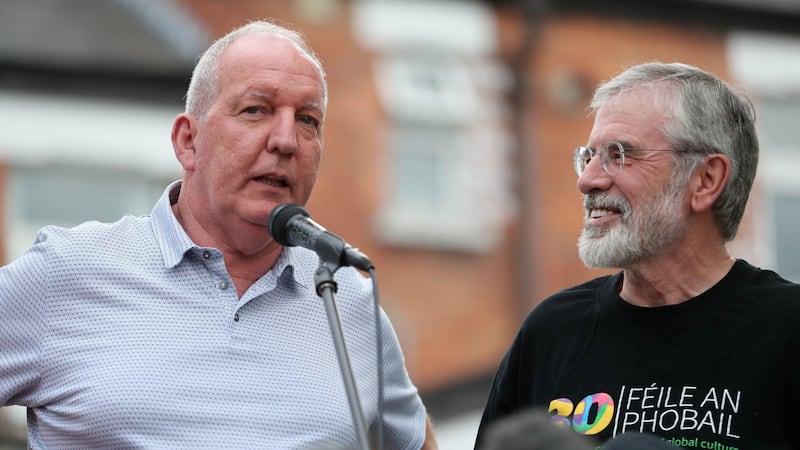
Studying his history, Storey, who was the IRA’s director of intelligence in the eyes of those who knew that world well, was “a planner, operator and an enforcer”.
Illustrating that latter side to him, one former police officer, recalled a beating delivered by Storey to another republican who had dared to challenge the Adams-McGuinness leadership at one of key moments in the peace process.
“The man was a repeat murderer, with a penchant for cutting people’s throats, but even he was scared of Bobby Storey,” the former officer recalled.
Though he rarely took the microphone outside of speaking to usually-private, sometimes public Sinn Féin gatherings, Storey was able to come up with the memorable quote when he had to go to the front of the stage.
One such moment came during a west Belfast press conference in August 2015 attended by Adams, the late Martin McGuinness, Mary Lou McDonald and some other leading republicans.
Matters were then fraught. Kevin McGuigan had just been shot dead in Belfast in a revenge murder for the killing of senior IRA figure Gerard “Jock” Davison that May.
Storey had been arrested for the McGuigan murder, but released without charge. The killing threatened the already shaky Northern Executive. Storey insisted that the IRA had had nothing to do with it.
The then PSNI chief constable George Hamilton had said some IRA members carried out McGuigan's murder, although they had acted without the authority of the leadership. Storey's denials were treated with scepticism.
“I think the chief constable and other perspectives out there see this in terms of the IRA being the caterpillar that is still there,” waxed Storey. “What I think is that it’s moved on, it’s become a butterfly, it’s flew away, it’s gone, it’s disappeared.”
The butterfly metaphor, which prompted a smile from Adams, had the colloquial colour and rhythm of a remark from one who could talk softly because they carried a big stick.
Storey was a "made man" in the IRA from his teens. In 1979, when in his early 20s, he was sent to London to try to free the late IRA leader Brian Keenan from Brixton prison using a helicopter.
It failed and Storey and three others were arrested. He was acquitted but in 1981 was sentenced to 18 years in prison over a gun attack on British soldiers.
That led to the Maze prison escape of 1983 and the beginning of Storey making his way into republican legend. Storey and North Belfast Assembly member Gerry Kelly were two of the masterminds in what was the biggest jailbreak in UK prison history, dubbed by republicans, The Great Escape, after the film. In all 38 IRA prisoners made it out of the prison gates in September 1983, half were recaptured but 19 got away.
Storey, too, was caught and had another seven years added to his sentence. Prison officer James Ferris who was stabbed during the escape died, although a court later ruled that it was a heart attack that killed him.
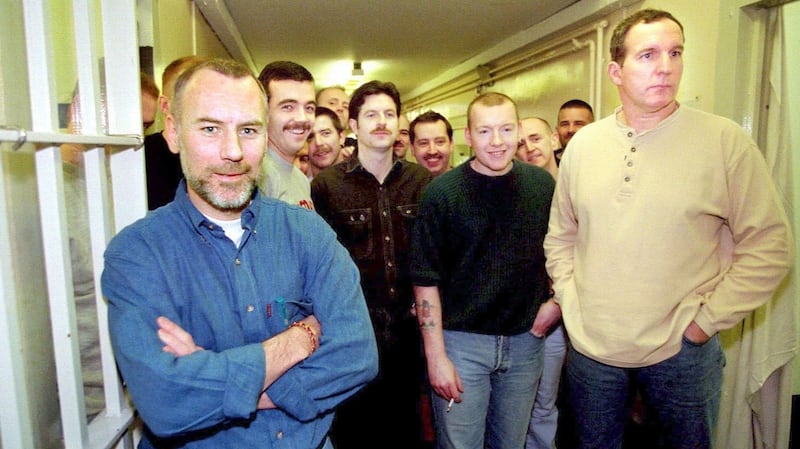
Storey in a 2008 interview with the republican paper An Phoblacht recalled the escape. "It was a great achievement for the IRA. It showed the degree to which comrades could work together, not just those who escaped but those who formed the back-up inside the jail, prisoners who weren't going on the escape. Then there was the teamwork of people outside the jail: the drivers, the safe houses. Even getting captured didn't dampen the event. We shafted Maggie Thatcher."
Storey probably is best known for the 2004 Northern Bank robbery. Adams and the IRA denied that the IRA did the job, and there are people who accept that denial, but not many.
Carried out on December 20th, 2004 at the Northern Bank's headquarters at Donegall Square West in Belfast, Northern Ireland, the robbers seized £26.5 m sterling, along with smaller amounts of other currents - the biggest bank robbery in British history.
The families of two Northern Bank officials were held at gunpoint on the night before while they were forced the following morning to report for work, as normal. One of the officials was forced to bring out £1m in cash stuffed into a holdall in a test run for the main robbery later that night. The two officials were forced to grant access to the robbers later that night into the bank, which had huge sums of cash in the vault in readiness to fill ATMs. Following the raid, Northern Bank recalled £300m worth of banknotes worth £10 or more, and issued new ones with new logos and new serial numbers
The robbery had been months in the planning, coming shortly after a failed attempt to resurrect the powersharing Executive and Assembly which had collapsed in 2002.
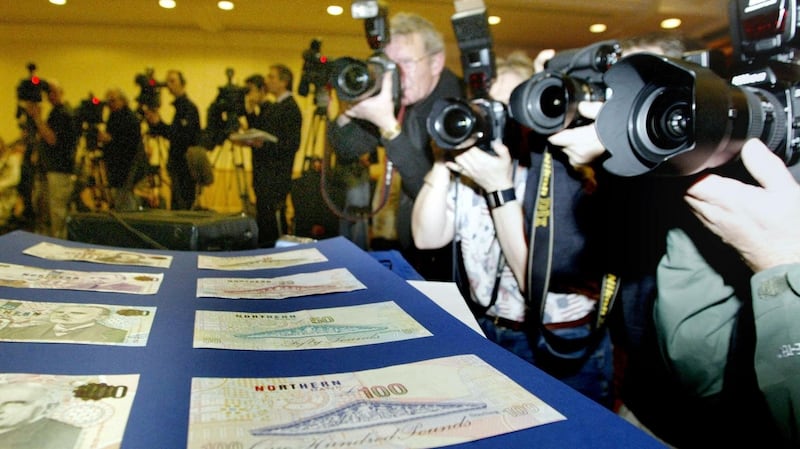
Intelligence and security services put Storey at the heart of its planning. "The robbery was carried out by the Belfast brigade, and Storey was a key player in the brigade, so he would have been up to his neck in it," said a former senior Police Service of Northern Ireland officer.
It should be remembered that the IRA was on ceasefire at the time and supposed to have eschewed such criminality. The same source recalled how over the years the IRA engaged in numerous bank, post office and other robberies. When Border fuel laundering and other activity was taken into account it all amounted to a multimillion pound criminal empire.
It prompted the late and former IRA member Dolours Price to comment at the time about slipping republican “standards” and to wonder: “The war is over, we are told . . . so what is all this money needed for?”
It is a question that has never been properly answered.
Storey had been involved in major robberies before. Stung by multiple truck hijackings in the early 2000s Gallaher's cigarette manufacturers in Ballymena began to ship supplies bound for Dublin first to Liverpool by ferry, and then onwards to Dublin.
The change soon drew the attention of the IRA to Gallaher’s use of Belfast port. In a raid in June 2001 that never drew the attention of the Northern Bank robbery, the IRA targeted a £4 million consignment of cigarettes bound for Rotterdam in the Netherlands.
The planning was impeccable, even in the words today of security sources. The Belfast brigade of the IRA provided the people, the IRA in south Armagh handled the logistics, while Storey was at the centre of the web.
“One night about 30 men appeared in Belfast dock. They took over the entire dock. They knew exactly what they were doing, they knew exactly what containers they were looking for, they knew exactly where those containers would be,” said one source.
“The only mistake they made was that they were a little bit late and a couple of those containers were loaded by the time they got to the quayside. So they put a gunman in the cab of the crane with the crane driver and made him unload them again.
“A fleet of lorries then appeared provided by the south Armagh brigade. The containers were dropped onto the lorries which headed off for the Border. The IRA held up the dock for another four hours, and then disappeared.
“By the time the alarm was raised I reckon some of those cigarettes were almost in Cork. Bobby Storey would have been at the heart of that as well.”
If the Gallaher’s raid made few headlines, the Northern Bank raid dominated bulletins across the world. Anxious to keep the IRA on board British prime minister Tony Blair’s “peace train”, the British authorities played down charges that the IRA was responsible for the cigarette job.
"But it was absolutely obvious who did it. No organisation in Northern Ireland had the capability to do that job but the IRA," said one security source involved in the investigation.
Then there was the St Patrick's night break-in in 2002 at the PSNI special branch offices at the Castlereagh police complex in east Belfast, supposedly one of the most impenetrable security centres in Europe. Three smartly-dressed men, one reputedly with an Oxbridge accent, almost casually got through the various checks, flashing what appeared to be genuine security passes.
It was a Sunday, a quiet night, and the men walked along the corridors of the building, just as IRA men did in the Belfast docks raid, knowing exactly where they were to go.
Within minutes, the three men were in the office where information about police agents, their police handlers and other highly-confidential documentation were kept.
They got out with that hoard just as easily as they got in, a lone constable in the office being punched in the face and then hooded, bound and gagged as the three carefully and methodically assembled their haul.
Millions of pounds were spent rehousing compromised detectives and others whose security was threatened by the break-in.
Highly embarrassed, then chief constable Ronnie Flanagan referred to the Castlereagh raid as "an inside job", giving rise to speculation that this was some sort of faction fight between the different elements of British intelligence. But it then emerged that Flanagan appeared to be referring to someone in Castlereagh assisting the three well-dressed robbers.
The IRA denied involvement while senior Sinn Féiners complained of dirty deeds by “British securocrats”, to use a favourite and much-used phrase of Adams.
Whitehall mandarin Sir John Chilcot, who later investigated the causes of the Iraq war, conducted an inquiry and found no evidence that any section of the British security agencies was involved.
Once more Storey was blamed. Remembering the raid, a former senior police officer has no doubts but that he was central. However, that same source believes that Storey was criticised internally by at least one Sinn Féin leader who, whatever about the haul of information found at the break-in, was unhappy with its timing because it put pressure on the Northern Executive and Assembly.
The then Ulster Unionist Party first minister David Trimble was under severe strain at the time for sharing power with Sinn Féin. Allegations that the on-ceasefire IRA had broken Castlereagh did nothing for his temperament, or his position.
Storey was seen as a man who had “sleepers” in many sensitive positions who could be used at opportune times. Storey, this individual believes, had “an asset” with knowledge of Castlereagh and that he decided to “use that asset, rather than lose it”. Not every element of the republican movement was kept in the loop by a man who kept secrets well.
Storey was said to run a meticulous, almost obsessive intelligence gathering operation. Every IRA brigade in Northern Ireland, possibly apart from south Armagh which tended to do its own thing, supplied information to him.
He carefully collated and stored it, much of it in a large bag, a “bit like a Gladstone bag”, according to the source. It was described in court as a “rucksack”.
“Republicans were reporting back intelligence all the time, picking up information on prison officers, on police officers, taking down car registrations, getting family details, where children went to school, getting gossip about people’s finances, who was having affairs – all of it being fed back to Bobby,” he explained.
It was around then, said the same source, that the PSNI devised a plan to bring him down. And here the story gets convoluted but it all leads up to Stormontgate in October of 2002.
Stormontgate
That month a long line of PSNI special branch and regular officers trooped into the offices of Sinn Féin at Parliament Buildings and seized material. Amid allegations of an IRA spy ring operating at Stormont – hence Stormontgate – Trimble could no longer hold his people together and the whole powersharing structure came crashing down, not to be rebuilt for close to another five years – an occasion in which Storey also featured.
Sinn Féin's head of administration at Stormont, Denis Donaldson was arrested, as were two other men, Donaldson's son-in-law Ciarán Kearney, and William Mackessy. Storey's "big bag" – stored in Donaldson's home – was seized during a PSNI raid.
They faced a range of charges but gradually some of them were withdrawn. In December 2005, the prosecution case ended, lawyers reporting it was no longer in the “public interest” to proceed with the case – a term that not infrequently is shorthand for protecting undercover sources or agents.
The following day, Friday, December 9th, Donaldson posed with Adams and McGuinness on the steps of Parliament Buildings, the three looking rather self-satisfied.
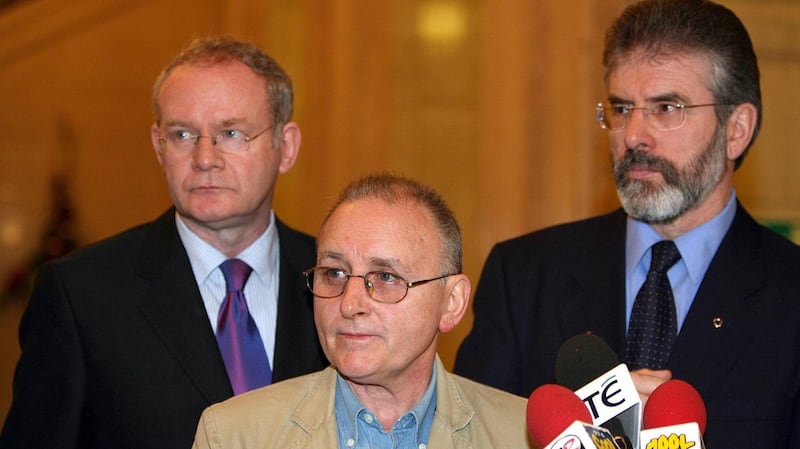
That did not last long. The following week a forlorn Donaldson gave a statement to the press admitting that for about 20 years he had acted as a British agent. At Stormont Donaldson came across as a quiet and decent individual who kept to the background. On that day he appeared pitiful. He went to live a life of isolation in a cottage near Glenties in Co Donegal where he was brutally murdered the following April. One of his arms was almost blown off by a shotgun blast. The Real IRA said it had killed him, but there are still questions over whether that was a genuine admission.
The outing of Donaldson allowed Adams and other Sinn Féiners to claim the whole Stormontgate affair was yet another example of a British “securocrat” conspiracy and that there was no republican spying at Stormont.
Again some people believe that version of events. The other story, as expressed by a number of security, official and other sources, was that the police were trying to get Storey in possession of that bag of secret documents. Revenge was required for Castlereagh.
In fact, said the former PSNI officer, the operation to nab Storey and other senior republicans had run for a long period. It was costly and involved many officers. But they just could not get the bag and Storey together. The PSNI for a long time knew Donaldson had the bag but were hoping for a “pass the parcel” moment when it would be handed over to the IRA director of intelligence.
The source explained: “The bag had been left temporarily with Denis Donaldson. It was destined for Bobby and we were trying to catch Bobby with it, with all those intelligence records and CDs, but we couldn’t in the end. Eventually it got to the stage where we ran out of resources and had to move on it and take Denis instead.”
One of the explanations for Donaldson’s arrest, even though he was an agent, was that he had not told his handlers about all the secret documentation. Another reason for the police moving in was fear that the material would be transported for safer keeping across the Border.
The result was that Storey escaped the net while millions of pounds were spent trying to safeguard the estimated 2,000 or so people, many of them prison, police and British army officers, some of them politicians, named in the documents.
The former officer also recalled how police did not get a chance to contact one particular man, an alleged drug dealer, on the list. “He was killed by the IRA, using one of its cover names, before he could be warned.”
Loyalty
Speaking after his death, Adams was strong in his tribute to Storey, saying that he was “one of the bravest people I have ever had the honour to know”.
“Whether inside or outside of prison, or through the years of harassment and beatings, arrests and torture from the RUC and British army, Big Bobby demonstrated time and time again his enormous personal commitment and courage,” he added.
In turn Storey had a fierce loyalty to Adams. In 2014, when Adams was arrested and questioned at Antrim police station for a number of days about the 1972 abduction, murder and secret burial of mother-of-10 Jean McConville, Storey rallied to his cause.
“That they would dare touch our party leader, the leader of Irish republicanism,” Storey thundered at a public gathering in west Belfast. At the same meeting Storey repeated a famous line from Adams about the IRA: “We have a message for the British government, for the Irish government, for the cabal that is out there: we ain’t gone away, you know.”
During research for this article, several political, security and republican sources have emphasised how critical Storey was to the peace process and strategy pursued by Adams and McGuinness. They provided the strategy, he provided the muscle to ensure they got their way.
He would have been fairly free with his fists when he had to. There were many, many people in the organisation who were frightened of him
Following the August 1994 IRA ceasefire, senior Sinn Féiners went to IRA units across Northern Ireland, and in the Republic, to argue for the peace strategy. Encouraged to speak up, a couple of IRA volunteers attending a meeting close to the Markets in central Belfast did so, and expressed their opposition to the ceasefire.
“During all of this Bobby sat at the back of the room,” said one well-placed source. “As the crowd were filtering out Bobby took those speakers aside and explained to them in words of one syllable what the consequences would be if they ever challenged the Adams-McGuinness leadership again. Bobby could be vicious, and they knew that.”
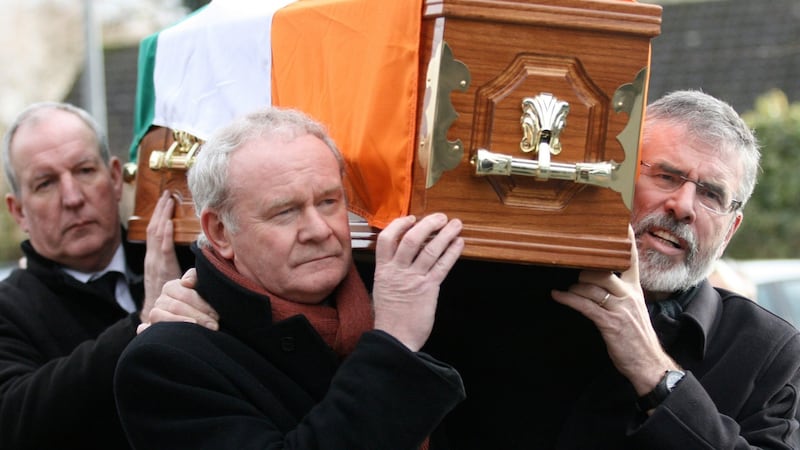
One very senior security figure was certain that Storey was important in ensuring that those within the IRA and Sinn Féin who opposed Adams and McGuinness never got the upper hand.
“We always believed that Bobby Storey was director of intelligence in the late 1990s and early noughties for the IRA,” he said. “He was very much a key player, extremely close to the leadership. His support for them was pretty vital in containing any individuals within the organisation who were threatening to throw over the traces, because they were all terrified of him.”
“I have no doubt that he played a positive role in making sure that any dissent within the organisation was suppressed,” he added.
“He would have been fairly free with his fists when he had to. There were many, many people in the organisation who were frightened of him. If he came around and supported the party leadership then there would be very few people who would cross him.”
At the funeral Adams quipped that he did not know anyone who knew Storey “who didn’t like him – except for MI5, MI6, the old RUC, the British army, and prison governors”. Still, he was not universally loved, even within republicanism.
In addition to those he threatened, there were other Republicans who had little time for Storey. One in particular was former IRA leader Ivor Bell who last year in court was cleared of soliciting Jean McConville's murder.
That case centred on testimony Bell gave on the Boston tapes – the ill-fated oral history of the Troubles – where it was alleged that one night in 1972, Bell, the late Pat McClure and Adams gathered to settle the terrible end of the life of Jean McConville.
Adams, who also gave evidence to the court, insisted no such meeting took place and that he had no part in the murder of the 38-year-old widow.
But in the tapes, where former IRA man Anthony McIntyre interviewed Bell, mention also is made of Storey. The court heard that when the IRA and Sinn Féin decided to assist in locating the bodies of McConville and others of the Disappeared Adams sent Storey to speak to Bell. This would have been around 1998-1999.
Storey’s task, it appeared from the tapes, was to elicit from Bell what he knew about the Disappeared. But it was clear that Bell felt that Adams was being disingenuous, which led to an infuriated Bell describing Storey as a “clown” and an “idiot” – terms that very few people would have used about him.
A clearly annoyed Bell said that he told Storey, “What are you asking me about it for, sure my knowledge of it would be second-hand, why don’t you ask Gerry?”
“Oh Gerry knows nothing about it,” Storey told Bell with an exasperated Bell saying to McIntyre, “the annoying thing is he actually believed Gerry.”
Storey was loved within most of the republican community but as with Bell there were those who despised him.
In July 2018, dissident republicans threw explosive devices at the homes of Adams and Storey in West Belfast. No one was injured. A rally there was quickly organised, with Storey telling dissidents they needed to “go back to where they come from”. “They were on a road to nowhere,” was a message he repeated on a number of occasions.
Youth
From teenage years Storey’s whole life was given over to the IRA and Sinn Féin. He joined the IRA when he was 16. Aged 17, he was one of the youngest to be interned in 1973. He served more than 20 years in prison, quite a lot of them on remand on various charges such as IRA shootings and bombings. Several sources said he was implicated in a number of killings but that because he was so long inside that he is rarely linked to some of the even more notorious multiple-death IRA gun and bomb attacks.
From the New Lodge in north Belfast, he said in the 2008 An Phoblacht interview that there was "an instinctive anti-British culture and politics" in his home. "But although there was a history of republicanism on my mother Peggy's side the main influences on me were the conditions around me," he said. "The dominant influences on me were the events that were going on around me, particularly the [1971 Ulster Volunteer Force] attack on McGurk's Bar in the New Lodge when 15 people were killed. Some of those killed would have known our family.
“Then there was the massacre on Bloody Sunday when 13 people were gunned down . . . The fact that British paratroopers could gun down innocent protesters had a massive impact on me and from that point on I was attempting to join the republican movement.”
Through the 2000s and as the IRA, to a relative degree considering the criminality, retreated into the shadows Sinn Féin leaders such as Adams saw the merit of bringing Storey more into the political fold. They tested the waters first by seeing how he would perform. On one occasion The Irish Times and other newspapers were invited to an off-the-record briefing where Storey, a little self-effacingly and with some reluctance, offered his thoughts on whatever was the political issue of that day. “I am not used to this,” he said, but then chatted away. There were no other such invitations for sit-down meetings with Storey.
Tall, strongly-built, and with a commanding presence, Storey could be an affable man, and with a good sense of humour. Equally, it was clear that he was not one to be crossed.
His civility did not stretch to all journalists. The Belfast writer and journalist Malachi O’Doherty, who has been a regular critic of Sinn Féin and the IRA, remembers how in the mid-1990s he was tackled by Storey after he had delivered a piece on BBC Radio Ulster’s Talkback programme in which he referred to Storey’s “enforcer” status.
Storey was 6ft 5in. O’Doherty is 5ft 2in, or little more. O’Doherty had been attending a lecture in the Felons’ Club in west Belfast when Storey approached him. O’Doherty recalled: “He put me up against a wall and told me I was a slug and not welcome in west Belfast.”
“After that incident another journalist went to speak to him and said, ‘Look what’s the score with Malachi?’ And he said, ‘Well, Malachi shouldn’t feel that he is free to just walk into west Belfast given that he has been so critical of us’.”
This was not a teasing, semi-jocular act by Storey, says O’Doherty: “Oh, no, it was clear intimidation of a journalist.”
Some people have characterised Storey as little more than an IRA hardman who carried out the orders given to him and who could barely think for himself. Anthony McIntyre, who spent time in prison with him and who was no friend of the Adams-McGuinness leadership, and who himself took some serious gyp from Storey, strongly contradicts that view.
He recalled occasions in prison when inmates were shown films. “I hated sitting beside him because no matter how complicated the plot of the film he’d work it out immediately and ruin it for you,” he said.
“He was very competent and very well got. He was absolutely hated by the cops, they absolutely despised him.
“He was exceptionally bright. I never found Bobby thuggish or a bully in a personal sense although a whole lot of others did. Whenever he was talking he always carried the authority of the IRA.”
“In terms of practical intelligence and practical ability you would meet nobody brighter. People used to say to me, ‘He is stupid’, and I would say back to them, ‘You are stupid for thinking he is stupid’. You don’t put operations like that together if you are stupid.”
Journalist Ivan Little while writing about Storey paramilitary past in the Belfast Telegraph also had a memory about his "softer" side. "At a talent contest I hosted in west Belfast some years ago he and his mother watched with pride as Storey's brother Brian who had Down's syndrome stole the show as an Elvis impersonator," he recalled.
But there are few such anecdotes.
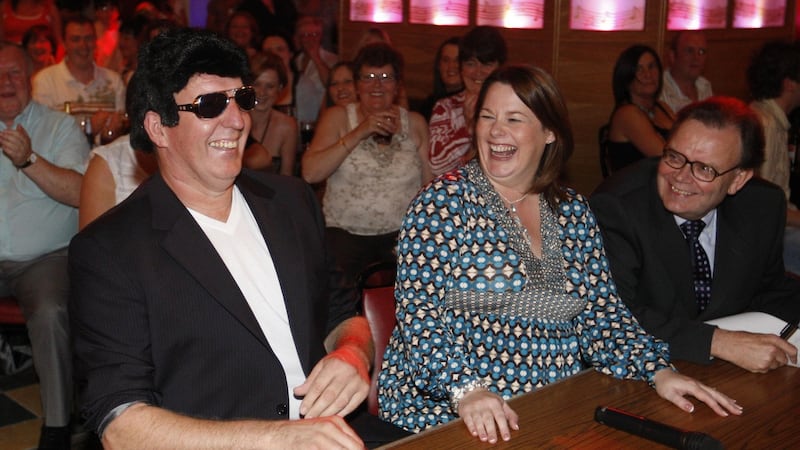
Across the Border he was also very well known to senior Garda and Army intelligence officers. “He was certainly on our radar; he figured a lot in our intelligence reports down the years, he was an interesting character,” said one former Garda source.
And while Storey is seldom mentioned as being on the IRA Army Council a former Army intelligence source said the view in the South was that “he was on the army council, or very close to it”.
“Membership of the army council was fluid; we think he was on it for a while. Storey was very influential. He mostly stayed behind the scenes but we had him at the very top of the tree,” he said.
That 2008 An Phoblacht interview was another example of Storey’s switch from paramilitarism to politics although one security source said that even in his Sinn Féin days “he was somewhere between the two”.
He held a senior position for Sinn Féin at Stormont and also served as party chairman for a period. He was a prominent backroom figure at times of political crises and during elections. He could energise the footsoldiers when the vote had to be got out. Perhaps jaundiced by the necessity to deal with journalists it seemed, however, that elected politics was not for him.
In his graveside oration Adams spoke about how Storey was devoted to his partner, Teresa, their children, and grandchildren, brothers Seamus and Brian, and sister Geraldine.
For all his “external intelligence success”, however, as one former senior Stormont official pointed out, “his failure was not applying intelligence internally and seeing how far PIRA [the Provisional IRA] had been penetrated – though arguably Castlereagh was about that”.
One of the repeated arguments from senior British security figures and some unionist politicians over the years is that a chief reason for the IRA finally ending its "war" was because it was so riddled with and damaged by informers and agents, some of them operating at very elevated levels such as Donaldson and Freddie Scappaticci, also known as Stakeknife, and some purported high-rankers yet to be exposed.
Differing views
There are different views of Storey. Most unionists and many others will see him as just another ruthless terrorist who was part of an IRA murder machine that killed up to 1,800 people and badly injured thousands more in an unjustifiable and unnecessary conflict.
That view was reflected in a piece in the Belfast Telegraph on the day before the funeral by historian Ruth Dudley Edwards which was headlined: “Bobby Storey: a violent thug who played role in the collapse of Stormont on three occasions”.
The counter view was offered in that same day's Irish News where senior republican Jim Gibney wrote: "If it is possible for one individual to embody the spirit, the dynamic, the duration and durability, the depth and complexity of the republican struggle over the last 45 years then it was Bobby Storey."
But in the often dispassionate warts and all world of the British and Irish intelligence and security services that battled with Storey and his like there remains an objective regard for his nerve and skill.
That same former Stormont official had one lasting memory of Storey that acknowledged his place in the republican hierarchy and in the "long war" tussle between the competing forces. It was May 2007, two months after Adams and Ian Paisley after much coaxing from the British and Irish governments, struck their truly historic deal to restore the Northern Executive and Assembly. This was after close to five years of direct rule from Westminster and now finally powersharing was being reinstated.
While below in the chamber the politicians went about the business of formally reactivating the Executive and Assembly, in the visitors' gallery above the likes of taoiseach Bertie Ahern, Blair and other VIPs observed proceedings, enjoying some of the reflected light of a job well done.
Just a few seats from them sat three of the most senior IRA figures of the Troubles, the late Brian Keenan, Brian Gillen and Bobby Storey.
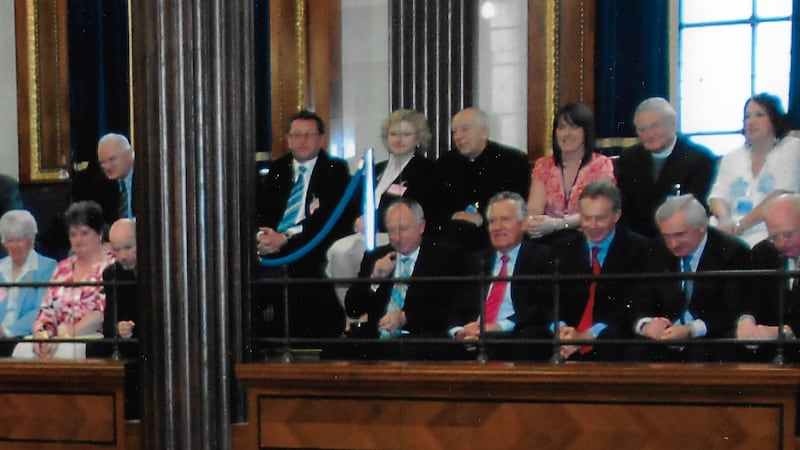
“This is how central he was to PIRA and also to the peace process – while it would have infuriated unionists, their presence was a vindication of the Adams strategy and the peace process,” said the former official.
He said that Blair and some of the other dignitaries “probably wouldn’t have recognised Storey anyway, which again says something about him”.
And in a neat encapsulation of Storey’s significant but in many way reticent place in republican history and in the peace process he added: “He was very low profile, as befits an intelligence person – he was an observer.
“But I do remember the respect my intelligence colleagues had for his operations. Quite apart from the Maze breakout to have planned the Northern Bank robbery and the Castlereagh break-in was extraordinary: respectively one of the largest bank robberies in history and the single biggest breach of UK national security ever. Quite a CV and he certainly didn’t lack ambition.”
















